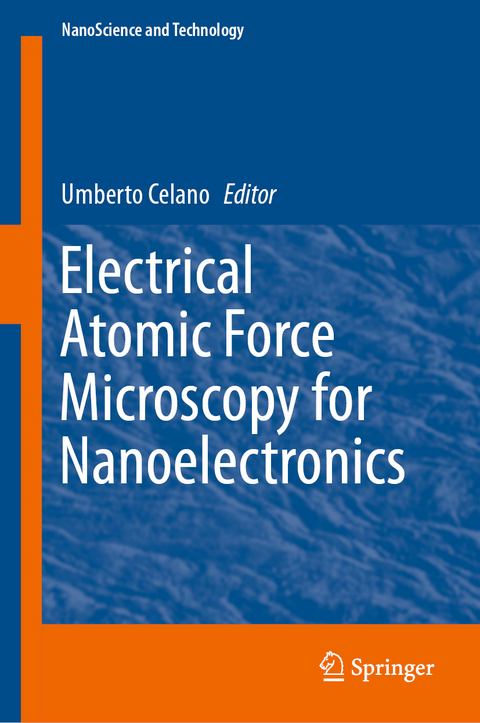
Electrical Atomic Force Microscopy for Nanoelectronics
Springer International Publishing (Verlag)
978-3-030-15611-4 (ISBN)
The tremendous impact of electronic devices on our lives is the result of continuous improvements of the billions of nanoelectronic components inside integrated circuits (ICs). However, ultra-scaled semiconductor devices require nanometer control of the many parameters essential for their fabrication. Through the years, this created a strong alliance between microscopy techniques and IC manufacturing. This book reviews the latest progress in IC devices, with emphasis on the impact of electrical atomic force microscopy (AFM) techniques for their development. The operation principles of many techniques are introduced, and the associated metrology challenges described. Blending the expertise of industrial specialists and academic researchers, the chapters are dedicated to various AFM methods and their impact on the development of emerging nanoelectronic devices. The goal is to introduce the major electrical AFM methods, following the journey that has seen our lives changedby the advent of ubiquitous nanoelectronics devices, and has extended our capability to sense matter on a scale previously inaccessible.
Umberto Celano is a senior research scientist at imec (Belgium), where his interests encompass solid-state physics and materials science for application in nanoelectronics and emerging devices. In this area, he conducted research at the border between engineering and fundamental science in various institutions such as KU Leuven, Osaka University, and Stanford University. He received his Ph.D. in Physics from the University of Leuven in 2015. Previously, Umberto obtained a B.Eng. in Electronic Engineering and an M.Sc. degree in Nanoelectronics from the University of Rome Sapienza, Italy.
Introduction (U. Celano, W. Vandervorst).- Conductive AFM for nanoscale analysis of high-k dielectric metal oxides (C. Rodenbücher, M. Wojtyniak, K. Szot).- Mapping Conductance and Carrier Distribution in Confined Three-Dimensional Transistor Structures (A. Schulze, P. Eyben, K. Paredis, L. Wouters, U. Celano, W. Vandervorst).- Scanning Capacitance Microscopy for two-dimensional carrier profiling of semiconductor devices (J. Mody, J. Nxumalo).- Scanning probe lithography for nanopatterning and fabrication of high-resolution devices (Y. K. Ryu, A. W. Knoll).- Characterizing Ferroelectricity with an Atomic Force Microscopy: an all-around technique (S. Martin, B. Gautier, N. Baboux, A. Gruvermann, A. Carretero-Genevrier, M. Gich, A. Gomez).- Electrical AFM for the analysis of Resistive Switching (S. Brivio, J. Frascaroli, M. H. Lee).- Magnetic force microscopy for magnetic recording and devices (A. Hirohata, M. Samiepour, M. Corbetta).- Nanoscale space charge density profiling with KPFM and photoconductive C-AFM/KPFM (C. Villeneuve-Faure, K. Makasheva, L. Boudou, G. Teyssedre).- Electrical AFM of 2D materials and heterostructures for nanoelectronics (F. Giannazzo, G. Greco, F. Roccaforte, C. Mahata, M. Lanza).- Diamond probes technology (T. Hantschel, T. Conard, J. Kilpatrick, G. Cross).- Scanning Microwave Impedance Microscopy (sMIM) in electronic materials and quantum materials (K. Rubin, Y. Yang, O. Amster, D. Scrymgeour, S. Misra).
| Erscheinungsdatum | 25.08.2019 |
|---|---|
| Reihe/Serie | NanoScience and Technology |
| Zusatzinfo | XX, 408 p. 256 illus., 230 illus. in color. |
| Verlagsort | Cham |
| Sprache | englisch |
| Maße | 155 x 235 mm |
| Gewicht | 799 g |
| Themenwelt | Naturwissenschaften ► Chemie ► Analytische Chemie |
| Naturwissenschaften ► Chemie ► Physikalische Chemie | |
| Naturwissenschaften ► Physik / Astronomie | |
| Schlagworte | atomic force microscope • Diamond tip for AFM • Ferroelectrics for logic and memory • High-k dielectric materials • Nanoelectronic devices • Nanoelectronic Materials • Nanoscale materials analysis • Scanning capacitance microscopy • VLSI metrology |
| ISBN-10 | 3-030-15611-7 / 3030156117 |
| ISBN-13 | 978-3-030-15611-4 / 9783030156114 |
| Zustand | Neuware |
| Haben Sie eine Frage zum Produkt? |
aus dem Bereich


